Essay: A Rhetorical Analysis of Mass Incarceration Article
VerifiedAdded on 2023/05/30
|8
|2407
|150
Essay
AI Summary
This essay presents a rhetorical analysis of Eli Hager's article, 'A Mass Incarceration Mystery,' focusing on the author's use of ethos, pathos, and logos to discuss incarceration trends in the United States. The analysis highlights how Hager employs statistical data to establish credibility (ethos), appeals to logic by examining the causes and effects of incarceration rates (logos), and evokes empathy by addressing racial disparities and socioeconomic factors (pathos). The essay argues that Hager effectively uses these rhetorical devices to raise awareness about the complexities of mass incarceration and its impact on different communities, concluding that the article successfully blends factual information with emotional appeals to engage readers and convey a nuanced understanding of the issue. Desklib offers a platform for students to explore similar essays and academic resources.
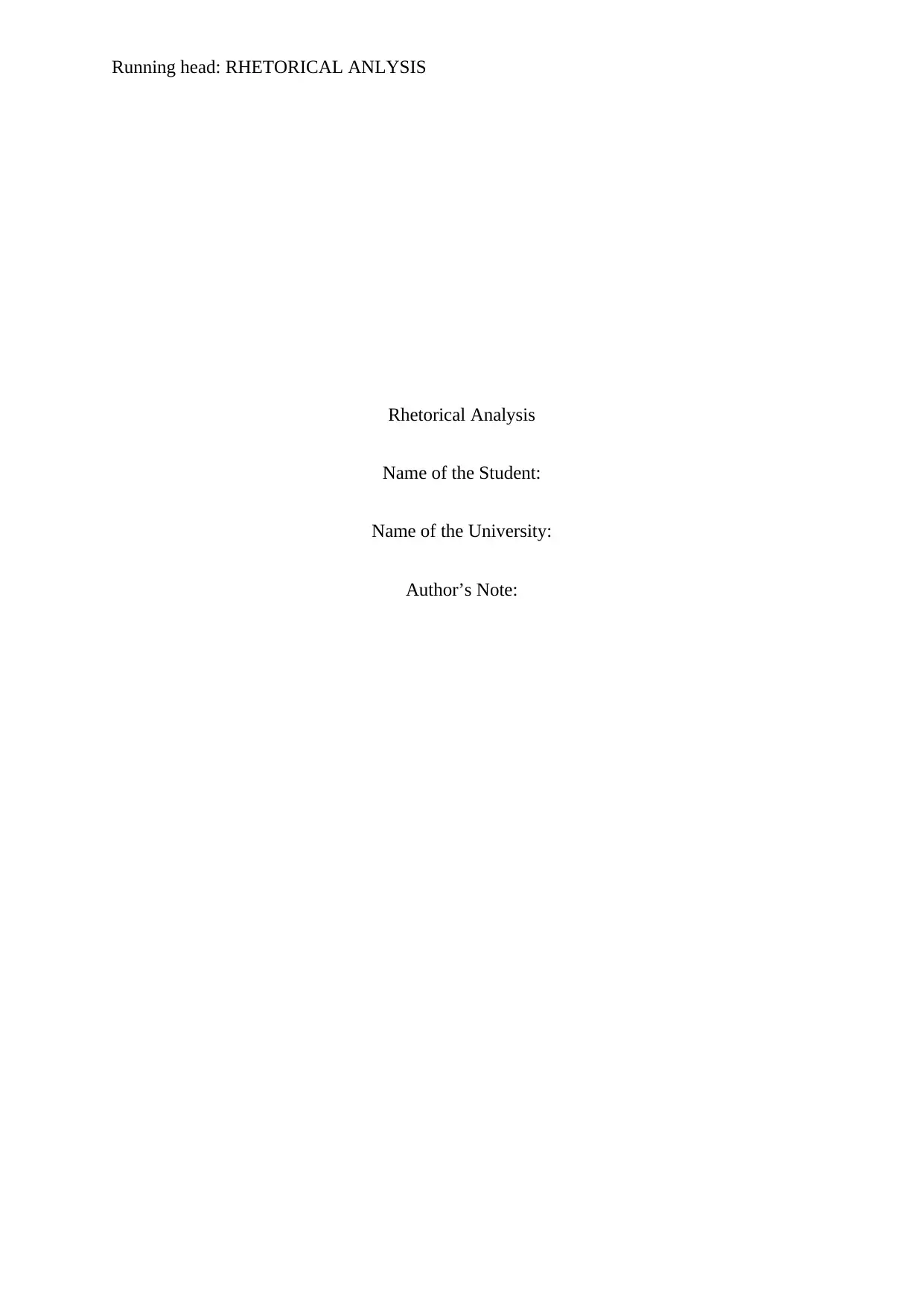
Running head: RHETORICAL ANLYSIS
Rhetorical Analysis
Name of the Student:
Name of the University:
Author’s Note:
Rhetorical Analysis
Name of the Student:
Name of the University:
Author’s Note:
Paraphrase This Document
Need a fresh take? Get an instant paraphrase of this document with our AI Paraphraser
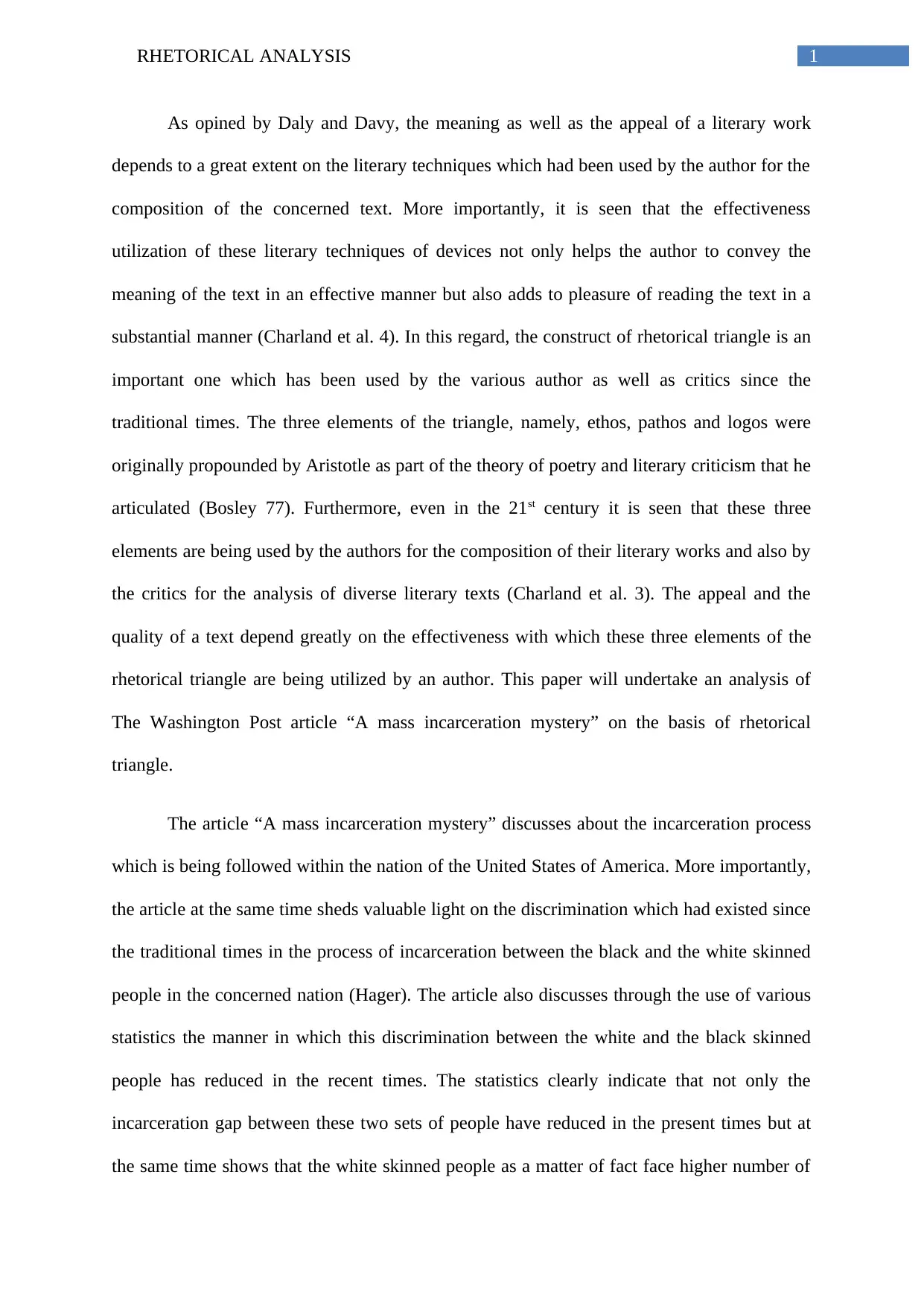
1RHETORICAL ANALYSIS
As opined by Daly and Davy, the meaning as well as the appeal of a literary work
depends to a great extent on the literary techniques which had been used by the author for the
composition of the concerned text. More importantly, it is seen that the effectiveness
utilization of these literary techniques of devices not only helps the author to convey the
meaning of the text in an effective manner but also adds to pleasure of reading the text in a
substantial manner (Charland et al. 4). In this regard, the construct of rhetorical triangle is an
important one which has been used by the various author as well as critics since the
traditional times. The three elements of the triangle, namely, ethos, pathos and logos were
originally propounded by Aristotle as part of the theory of poetry and literary criticism that he
articulated (Bosley 77). Furthermore, even in the 21st century it is seen that these three
elements are being used by the authors for the composition of their literary works and also by
the critics for the analysis of diverse literary texts (Charland et al. 3). The appeal and the
quality of a text depend greatly on the effectiveness with which these three elements of the
rhetorical triangle are being utilized by an author. This paper will undertake an analysis of
The Washington Post article “A mass incarceration mystery” on the basis of rhetorical
triangle.
The article “A mass incarceration mystery” discusses about the incarceration process
which is being followed within the nation of the United States of America. More importantly,
the article at the same time sheds valuable light on the discrimination which had existed since
the traditional times in the process of incarceration between the black and the white skinned
people in the concerned nation (Hager). The article also discusses through the use of various
statistics the manner in which this discrimination between the white and the black skinned
people has reduced in the recent times. The statistics clearly indicate that not only the
incarceration gap between these two sets of people have reduced in the present times but at
the same time shows that the white skinned people as a matter of fact face higher number of
As opined by Daly and Davy, the meaning as well as the appeal of a literary work
depends to a great extent on the literary techniques which had been used by the author for the
composition of the concerned text. More importantly, it is seen that the effectiveness
utilization of these literary techniques of devices not only helps the author to convey the
meaning of the text in an effective manner but also adds to pleasure of reading the text in a
substantial manner (Charland et al. 4). In this regard, the construct of rhetorical triangle is an
important one which has been used by the various author as well as critics since the
traditional times. The three elements of the triangle, namely, ethos, pathos and logos were
originally propounded by Aristotle as part of the theory of poetry and literary criticism that he
articulated (Bosley 77). Furthermore, even in the 21st century it is seen that these three
elements are being used by the authors for the composition of their literary works and also by
the critics for the analysis of diverse literary texts (Charland et al. 3). The appeal and the
quality of a text depend greatly on the effectiveness with which these three elements of the
rhetorical triangle are being utilized by an author. This paper will undertake an analysis of
The Washington Post article “A mass incarceration mystery” on the basis of rhetorical
triangle.
The article “A mass incarceration mystery” discusses about the incarceration process
which is being followed within the nation of the United States of America. More importantly,
the article at the same time sheds valuable light on the discrimination which had existed since
the traditional times in the process of incarceration between the black and the white skinned
people in the concerned nation (Hager). The article also discusses through the use of various
statistics the manner in which this discrimination between the white and the black skinned
people has reduced in the recent times. The statistics clearly indicate that not only the
incarceration gap between these two sets of people have reduced in the present times but at
the same time shows that the white skinned people as a matter of fact face higher number of
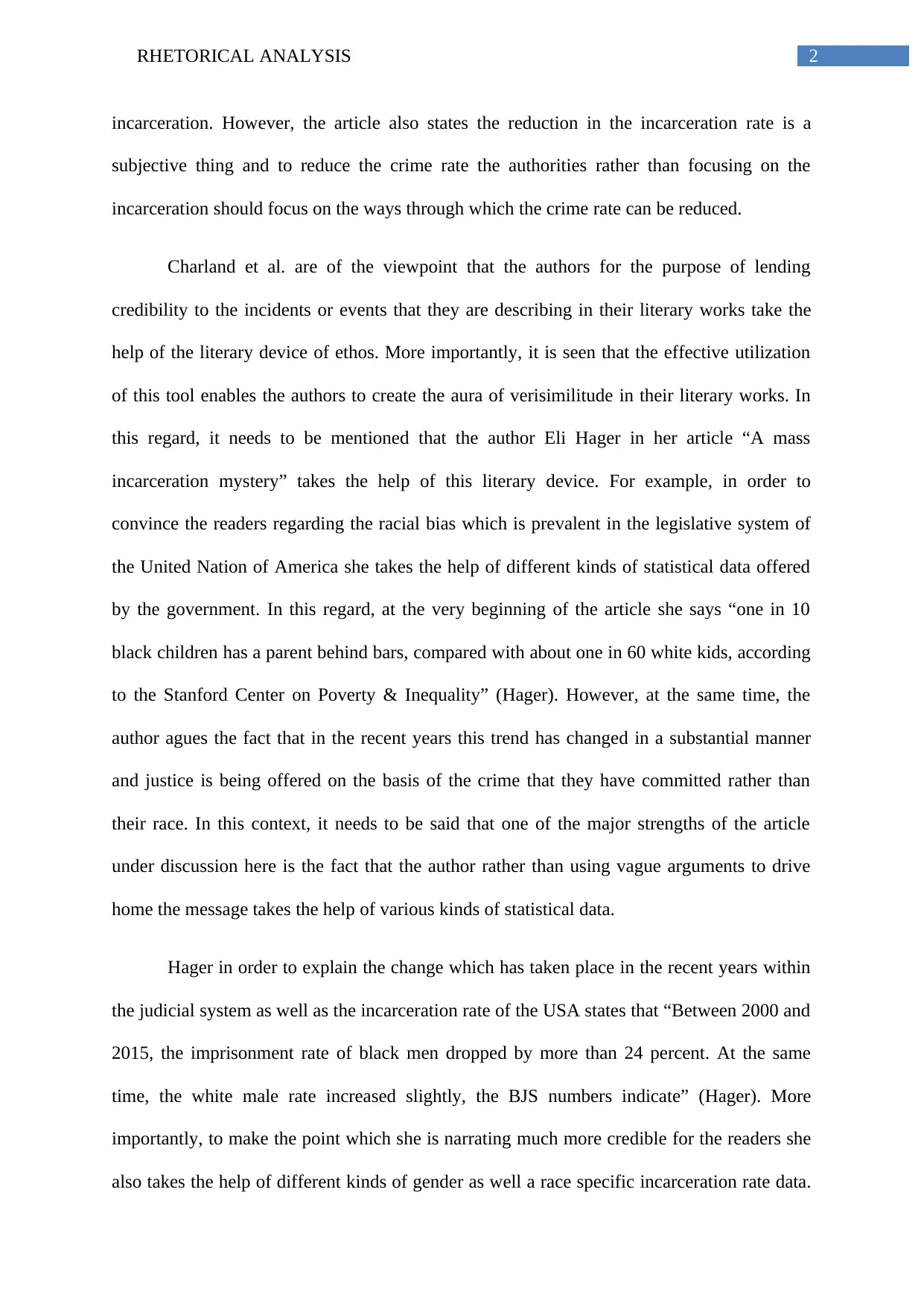
2RHETORICAL ANALYSIS
incarceration. However, the article also states the reduction in the incarceration rate is a
subjective thing and to reduce the crime rate the authorities rather than focusing on the
incarceration should focus on the ways through which the crime rate can be reduced.
Charland et al. are of the viewpoint that the authors for the purpose of lending
credibility to the incidents or events that they are describing in their literary works take the
help of the literary device of ethos. More importantly, it is seen that the effective utilization
of this tool enables the authors to create the aura of verisimilitude in their literary works. In
this regard, it needs to be mentioned that the author Eli Hager in her article “A mass
incarceration mystery” takes the help of this literary device. For example, in order to
convince the readers regarding the racial bias which is prevalent in the legislative system of
the United Nation of America she takes the help of different kinds of statistical data offered
by the government. In this regard, at the very beginning of the article she says “one in 10
black children has a parent behind bars, compared with about one in 60 white kids, according
to the Stanford Center on Poverty & Inequality” (Hager). However, at the same time, the
author agues the fact that in the recent years this trend has changed in a substantial manner
and justice is being offered on the basis of the crime that they have committed rather than
their race. In this context, it needs to be said that one of the major strengths of the article
under discussion here is the fact that the author rather than using vague arguments to drive
home the message takes the help of various kinds of statistical data.
Hager in order to explain the change which has taken place in the recent years within
the judicial system as well as the incarceration rate of the USA states that “Between 2000 and
2015, the imprisonment rate of black men dropped by more than 24 percent. At the same
time, the white male rate increased slightly, the BJS numbers indicate” (Hager). More
importantly, to make the point which she is narrating much more credible for the readers she
also takes the help of different kinds of gender as well a race specific incarceration rate data.
incarceration. However, the article also states the reduction in the incarceration rate is a
subjective thing and to reduce the crime rate the authorities rather than focusing on the
incarceration should focus on the ways through which the crime rate can be reduced.
Charland et al. are of the viewpoint that the authors for the purpose of lending
credibility to the incidents or events that they are describing in their literary works take the
help of the literary device of ethos. More importantly, it is seen that the effective utilization
of this tool enables the authors to create the aura of verisimilitude in their literary works. In
this regard, it needs to be mentioned that the author Eli Hager in her article “A mass
incarceration mystery” takes the help of this literary device. For example, in order to
convince the readers regarding the racial bias which is prevalent in the legislative system of
the United Nation of America she takes the help of different kinds of statistical data offered
by the government. In this regard, at the very beginning of the article she says “one in 10
black children has a parent behind bars, compared with about one in 60 white kids, according
to the Stanford Center on Poverty & Inequality” (Hager). However, at the same time, the
author agues the fact that in the recent years this trend has changed in a substantial manner
and justice is being offered on the basis of the crime that they have committed rather than
their race. In this context, it needs to be said that one of the major strengths of the article
under discussion here is the fact that the author rather than using vague arguments to drive
home the message takes the help of various kinds of statistical data.
Hager in order to explain the change which has taken place in the recent years within
the judicial system as well as the incarceration rate of the USA states that “Between 2000 and
2015, the imprisonment rate of black men dropped by more than 24 percent. At the same
time, the white male rate increased slightly, the BJS numbers indicate” (Hager). More
importantly, to make the point which she is narrating much more credible for the readers she
also takes the help of different kinds of gender as well a race specific incarceration rate data.
⊘ This is a preview!⊘
Do you want full access?
Subscribe today to unlock all pages.

Trusted by 1+ million students worldwide
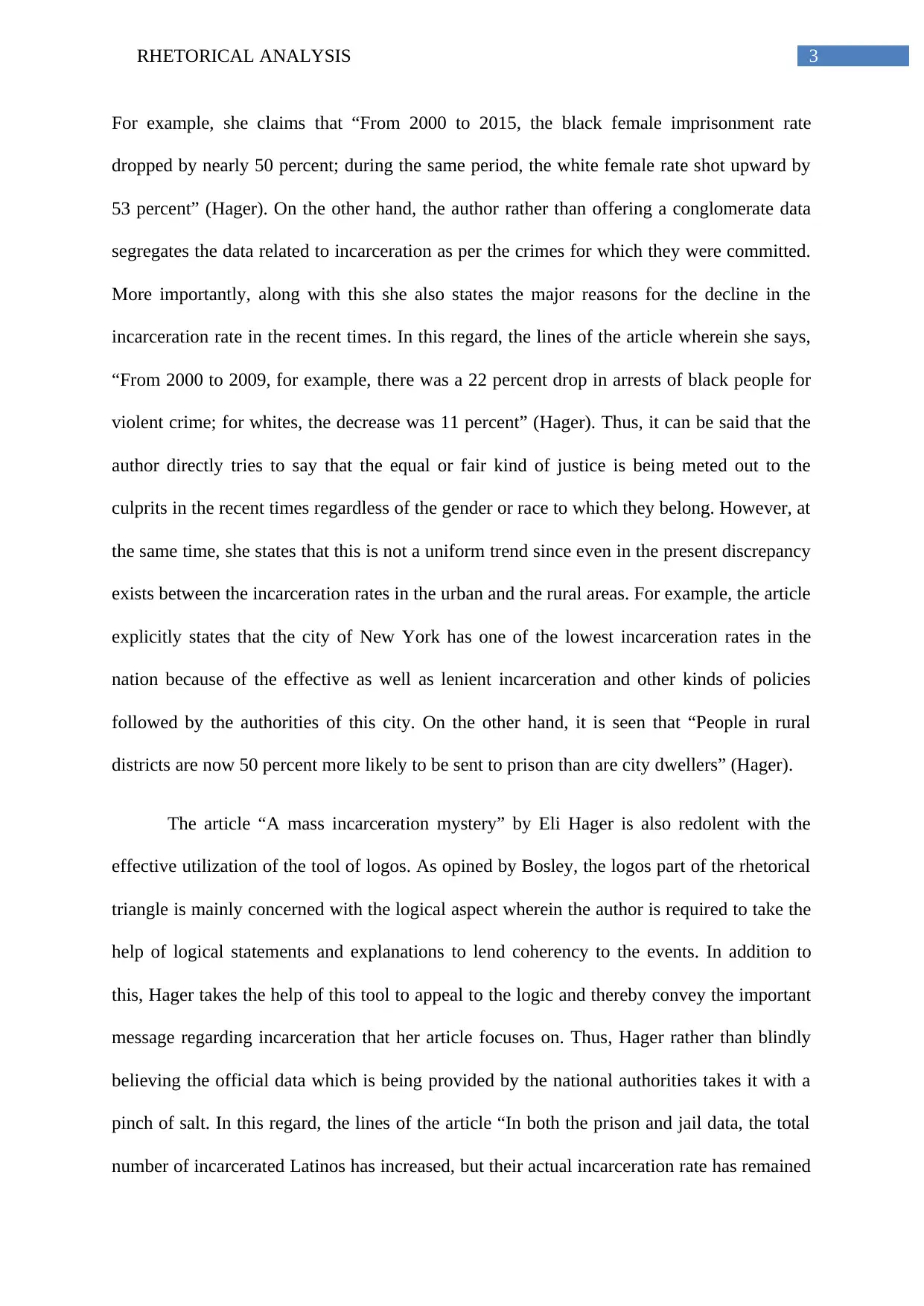
3RHETORICAL ANALYSIS
For example, she claims that “From 2000 to 2015, the black female imprisonment rate
dropped by nearly 50 percent; during the same period, the white female rate shot upward by
53 percent” (Hager). On the other hand, the author rather than offering a conglomerate data
segregates the data related to incarceration as per the crimes for which they were committed.
More importantly, along with this she also states the major reasons for the decline in the
incarceration rate in the recent times. In this regard, the lines of the article wherein she says,
“From 2000 to 2009, for example, there was a 22 percent drop in arrests of black people for
violent crime; for whites, the decrease was 11 percent” (Hager). Thus, it can be said that the
author directly tries to say that the equal or fair kind of justice is being meted out to the
culprits in the recent times regardless of the gender or race to which they belong. However, at
the same time, she states that this is not a uniform trend since even in the present discrepancy
exists between the incarceration rates in the urban and the rural areas. For example, the article
explicitly states that the city of New York has one of the lowest incarceration rates in the
nation because of the effective as well as lenient incarceration and other kinds of policies
followed by the authorities of this city. On the other hand, it is seen that “People in rural
districts are now 50 percent more likely to be sent to prison than are city dwellers” (Hager).
The article “A mass incarceration mystery” by Eli Hager is also redolent with the
effective utilization of the tool of logos. As opined by Bosley, the logos part of the rhetorical
triangle is mainly concerned with the logical aspect wherein the author is required to take the
help of logical statements and explanations to lend coherency to the events. In addition to
this, Hager takes the help of this tool to appeal to the logic and thereby convey the important
message regarding incarceration that her article focuses on. Thus, Hager rather than blindly
believing the official data which is being provided by the national authorities takes it with a
pinch of salt. In this regard, the lines of the article “In both the prison and jail data, the total
number of incarcerated Latinos has increased, but their actual incarceration rate has remained
For example, she claims that “From 2000 to 2015, the black female imprisonment rate
dropped by nearly 50 percent; during the same period, the white female rate shot upward by
53 percent” (Hager). On the other hand, the author rather than offering a conglomerate data
segregates the data related to incarceration as per the crimes for which they were committed.
More importantly, along with this she also states the major reasons for the decline in the
incarceration rate in the recent times. In this regard, the lines of the article wherein she says,
“From 2000 to 2009, for example, there was a 22 percent drop in arrests of black people for
violent crime; for whites, the decrease was 11 percent” (Hager). Thus, it can be said that the
author directly tries to say that the equal or fair kind of justice is being meted out to the
culprits in the recent times regardless of the gender or race to which they belong. However, at
the same time, she states that this is not a uniform trend since even in the present discrepancy
exists between the incarceration rates in the urban and the rural areas. For example, the article
explicitly states that the city of New York has one of the lowest incarceration rates in the
nation because of the effective as well as lenient incarceration and other kinds of policies
followed by the authorities of this city. On the other hand, it is seen that “People in rural
districts are now 50 percent more likely to be sent to prison than are city dwellers” (Hager).
The article “A mass incarceration mystery” by Eli Hager is also redolent with the
effective utilization of the tool of logos. As opined by Bosley, the logos part of the rhetorical
triangle is mainly concerned with the logical aspect wherein the author is required to take the
help of logical statements and explanations to lend coherency to the events. In addition to
this, Hager takes the help of this tool to appeal to the logic and thereby convey the important
message regarding incarceration that her article focuses on. Thus, Hager rather than blindly
believing the official data which is being provided by the national authorities takes it with a
pinch of salt. In this regard, the lines of the article “In both the prison and jail data, the total
number of incarcerated Latinos has increased, but their actual incarceration rate has remained
Paraphrase This Document
Need a fresh take? Get an instant paraphrase of this document with our AI Paraphraser
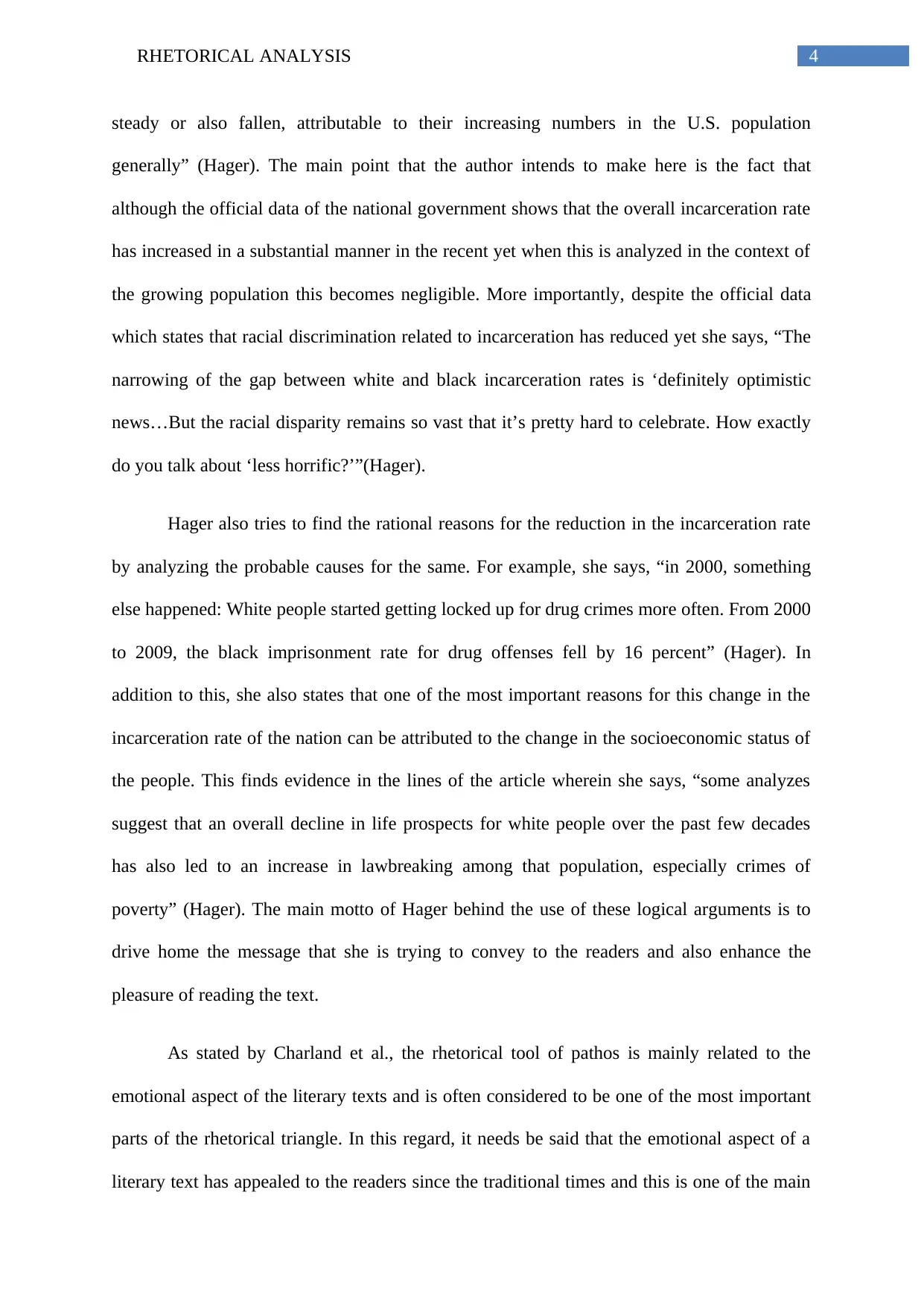
4RHETORICAL ANALYSIS
steady or also fallen, attributable to their increasing numbers in the U.S. population
generally” (Hager). The main point that the author intends to make here is the fact that
although the official data of the national government shows that the overall incarceration rate
has increased in a substantial manner in the recent yet when this is analyzed in the context of
the growing population this becomes negligible. More importantly, despite the official data
which states that racial discrimination related to incarceration has reduced yet she says, “The
narrowing of the gap between white and black incarceration rates is ‘definitely optimistic
news…But the racial disparity remains so vast that it’s pretty hard to celebrate. How exactly
do you talk about ‘less horrific?’”(Hager).
Hager also tries to find the rational reasons for the reduction in the incarceration rate
by analyzing the probable causes for the same. For example, she says, “in 2000, something
else happened: White people started getting locked up for drug crimes more often. From 2000
to 2009, the black imprisonment rate for drug offenses fell by 16 percent” (Hager). In
addition to this, she also states that one of the most important reasons for this change in the
incarceration rate of the nation can be attributed to the change in the socioeconomic status of
the people. This finds evidence in the lines of the article wherein she says, “some analyzes
suggest that an overall decline in life prospects for white people over the past few decades
has also led to an increase in lawbreaking among that population, especially crimes of
poverty” (Hager). The main motto of Hager behind the use of these logical arguments is to
drive home the message that she is trying to convey to the readers and also enhance the
pleasure of reading the text.
As stated by Charland et al., the rhetorical tool of pathos is mainly related to the
emotional aspect of the literary texts and is often considered to be one of the most important
parts of the rhetorical triangle. In this regard, it needs be said that the emotional aspect of a
literary text has appealed to the readers since the traditional times and this is one of the main
steady or also fallen, attributable to their increasing numbers in the U.S. population
generally” (Hager). The main point that the author intends to make here is the fact that
although the official data of the national government shows that the overall incarceration rate
has increased in a substantial manner in the recent yet when this is analyzed in the context of
the growing population this becomes negligible. More importantly, despite the official data
which states that racial discrimination related to incarceration has reduced yet she says, “The
narrowing of the gap between white and black incarceration rates is ‘definitely optimistic
news…But the racial disparity remains so vast that it’s pretty hard to celebrate. How exactly
do you talk about ‘less horrific?’”(Hager).
Hager also tries to find the rational reasons for the reduction in the incarceration rate
by analyzing the probable causes for the same. For example, she says, “in 2000, something
else happened: White people started getting locked up for drug crimes more often. From 2000
to 2009, the black imprisonment rate for drug offenses fell by 16 percent” (Hager). In
addition to this, she also states that one of the most important reasons for this change in the
incarceration rate of the nation can be attributed to the change in the socioeconomic status of
the people. This finds evidence in the lines of the article wherein she says, “some analyzes
suggest that an overall decline in life prospects for white people over the past few decades
has also led to an increase in lawbreaking among that population, especially crimes of
poverty” (Hager). The main motto of Hager behind the use of these logical arguments is to
drive home the message that she is trying to convey to the readers and also enhance the
pleasure of reading the text.
As stated by Charland et al., the rhetorical tool of pathos is mainly related to the
emotional aspect of the literary texts and is often considered to be one of the most important
parts of the rhetorical triangle. In this regard, it needs be said that the emotional aspect of a
literary text has appealed to the readers since the traditional times and this is one of the main
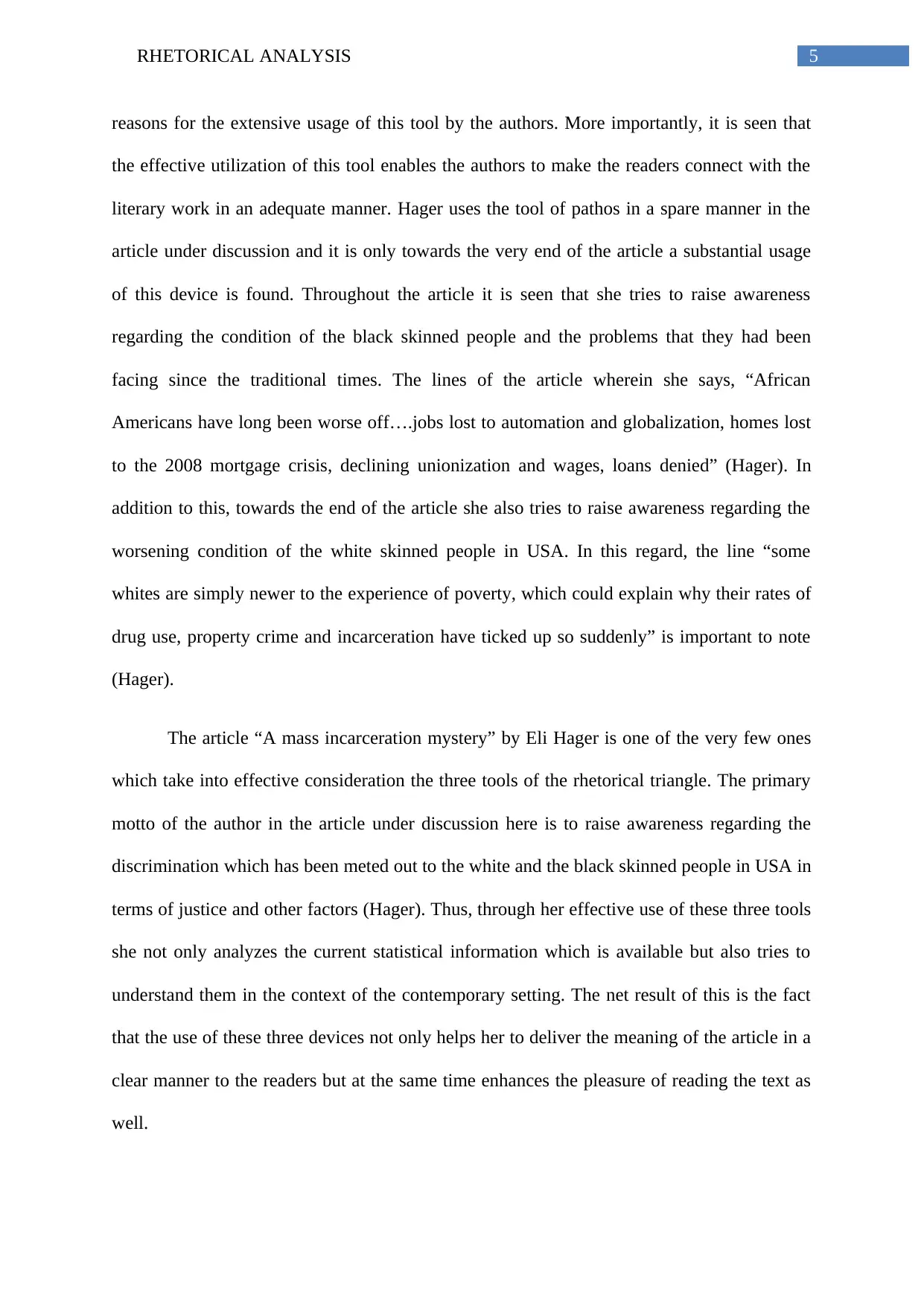
5RHETORICAL ANALYSIS
reasons for the extensive usage of this tool by the authors. More importantly, it is seen that
the effective utilization of this tool enables the authors to make the readers connect with the
literary work in an adequate manner. Hager uses the tool of pathos in a spare manner in the
article under discussion and it is only towards the very end of the article a substantial usage
of this device is found. Throughout the article it is seen that she tries to raise awareness
regarding the condition of the black skinned people and the problems that they had been
facing since the traditional times. The lines of the article wherein she says, “African
Americans have long been worse off….jobs lost to automation and globalization, homes lost
to the 2008 mortgage crisis, declining unionization and wages, loans denied” (Hager). In
addition to this, towards the end of the article she also tries to raise awareness regarding the
worsening condition of the white skinned people in USA. In this regard, the line “some
whites are simply newer to the experience of poverty, which could explain why their rates of
drug use, property crime and incarceration have ticked up so suddenly” is important to note
(Hager).
The article “A mass incarceration mystery” by Eli Hager is one of the very few ones
which take into effective consideration the three tools of the rhetorical triangle. The primary
motto of the author in the article under discussion here is to raise awareness regarding the
discrimination which has been meted out to the white and the black skinned people in USA in
terms of justice and other factors (Hager). Thus, through her effective use of these three tools
she not only analyzes the current statistical information which is available but also tries to
understand them in the context of the contemporary setting. The net result of this is the fact
that the use of these three devices not only helps her to deliver the meaning of the article in a
clear manner to the readers but at the same time enhances the pleasure of reading the text as
well.
reasons for the extensive usage of this tool by the authors. More importantly, it is seen that
the effective utilization of this tool enables the authors to make the readers connect with the
literary work in an adequate manner. Hager uses the tool of pathos in a spare manner in the
article under discussion and it is only towards the very end of the article a substantial usage
of this device is found. Throughout the article it is seen that she tries to raise awareness
regarding the condition of the black skinned people and the problems that they had been
facing since the traditional times. The lines of the article wherein she says, “African
Americans have long been worse off….jobs lost to automation and globalization, homes lost
to the 2008 mortgage crisis, declining unionization and wages, loans denied” (Hager). In
addition to this, towards the end of the article she also tries to raise awareness regarding the
worsening condition of the white skinned people in USA. In this regard, the line “some
whites are simply newer to the experience of poverty, which could explain why their rates of
drug use, property crime and incarceration have ticked up so suddenly” is important to note
(Hager).
The article “A mass incarceration mystery” by Eli Hager is one of the very few ones
which take into effective consideration the three tools of the rhetorical triangle. The primary
motto of the author in the article under discussion here is to raise awareness regarding the
discrimination which has been meted out to the white and the black skinned people in USA in
terms of justice and other factors (Hager). Thus, through her effective use of these three tools
she not only analyzes the current statistical information which is available but also tries to
understand them in the context of the contemporary setting. The net result of this is the fact
that the use of these three devices not only helps her to deliver the meaning of the article in a
clear manner to the readers but at the same time enhances the pleasure of reading the text as
well.
⊘ This is a preview!⊘
Do you want full access?
Subscribe today to unlock all pages.

Trusted by 1+ million students worldwide
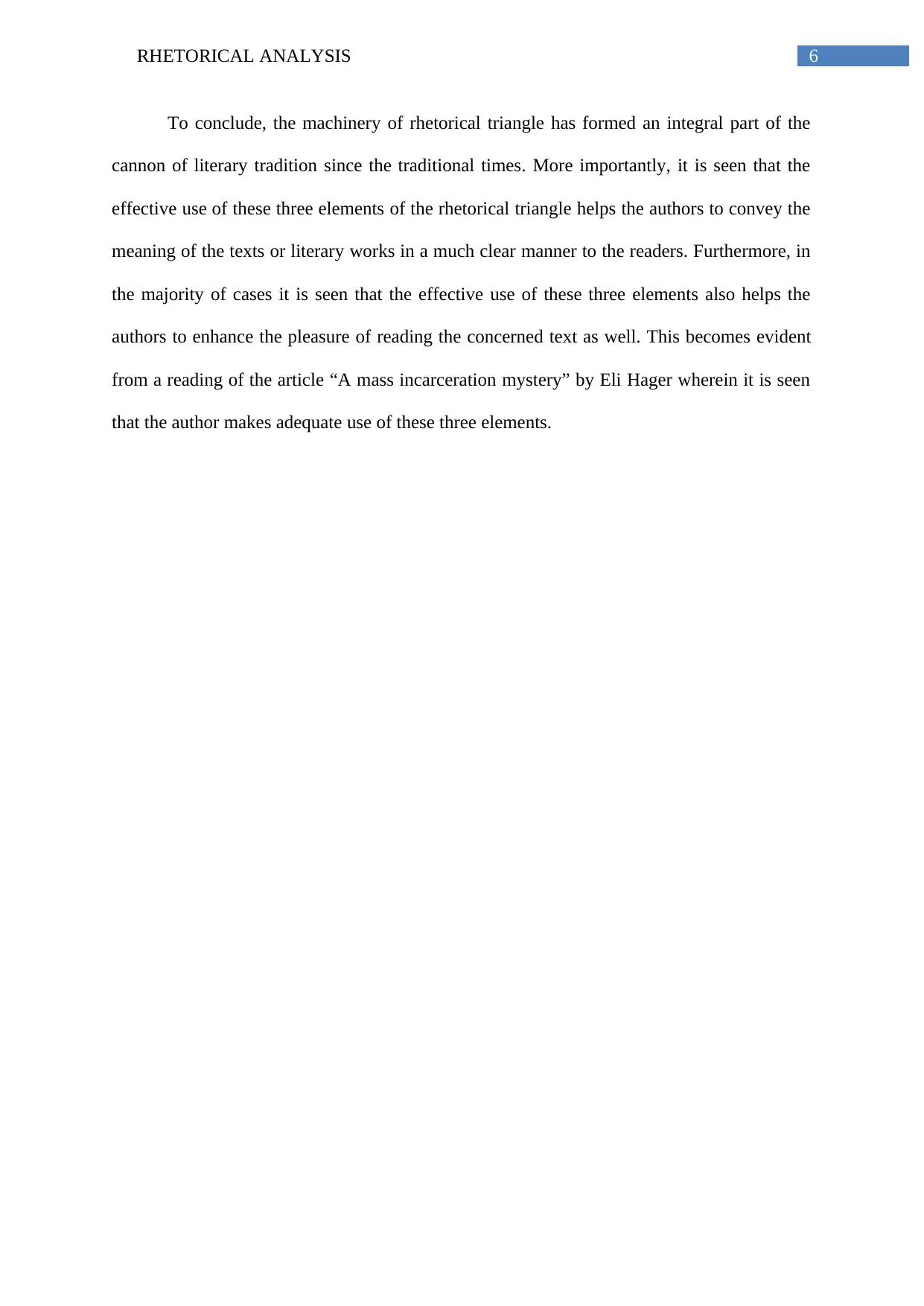
6RHETORICAL ANALYSIS
To conclude, the machinery of rhetorical triangle has formed an integral part of the
cannon of literary tradition since the traditional times. More importantly, it is seen that the
effective use of these three elements of the rhetorical triangle helps the authors to convey the
meaning of the texts or literary works in a much clear manner to the readers. Furthermore, in
the majority of cases it is seen that the effective use of these three elements also helps the
authors to enhance the pleasure of reading the concerned text as well. This becomes evident
from a reading of the article “A mass incarceration mystery” by Eli Hager wherein it is seen
that the author makes adequate use of these three elements.
To conclude, the machinery of rhetorical triangle has formed an integral part of the
cannon of literary tradition since the traditional times. More importantly, it is seen that the
effective use of these three elements of the rhetorical triangle helps the authors to convey the
meaning of the texts or literary works in a much clear manner to the readers. Furthermore, in
the majority of cases it is seen that the effective use of these three elements also helps the
authors to enhance the pleasure of reading the concerned text as well. This becomes evident
from a reading of the article “A mass incarceration mystery” by Eli Hager wherein it is seen
that the author makes adequate use of these three elements.
Paraphrase This Document
Need a fresh take? Get an instant paraphrase of this document with our AI Paraphraser
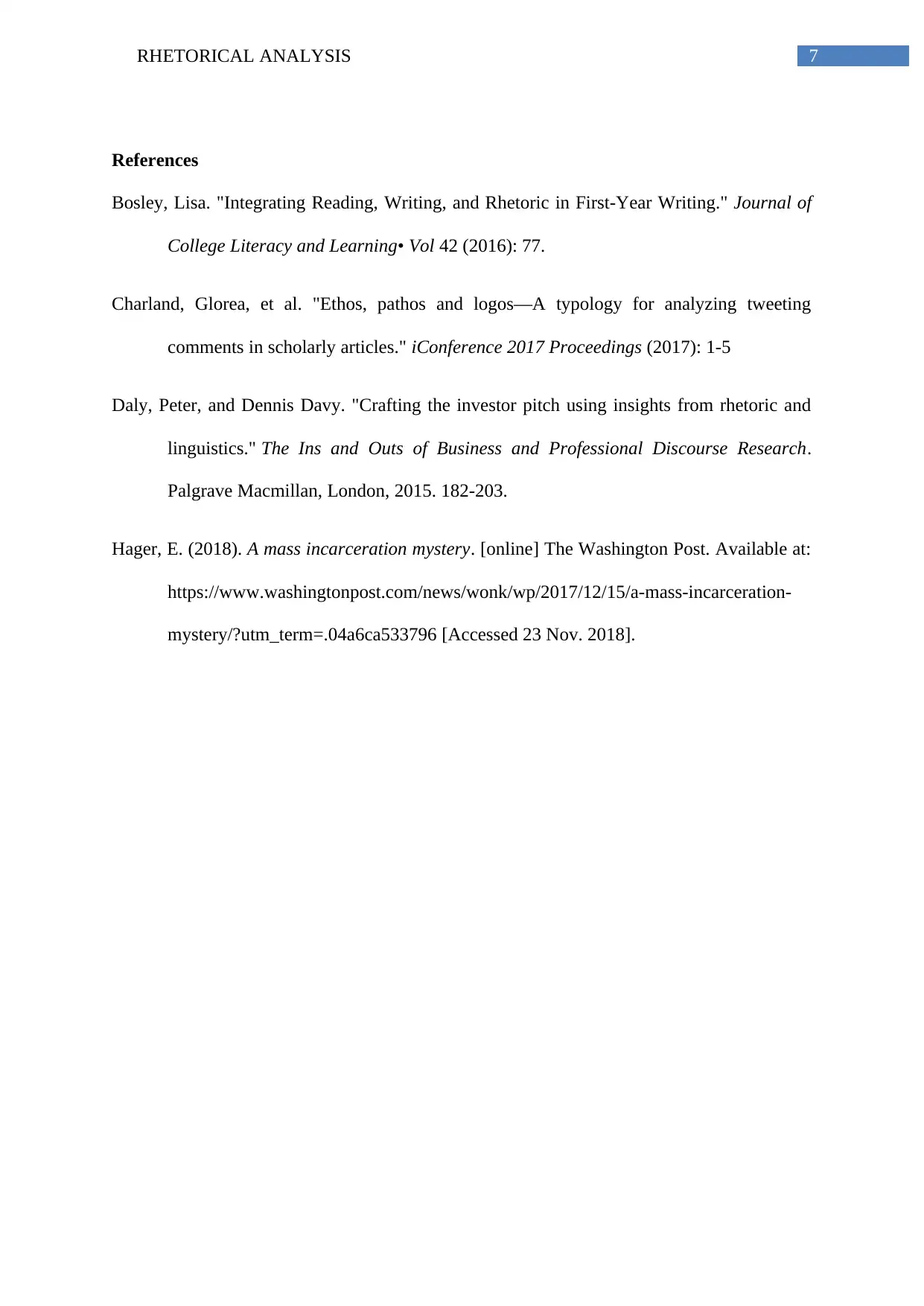
7RHETORICAL ANALYSIS
References
Bosley, Lisa. "Integrating Reading, Writing, and Rhetoric in First-Year Writing." Journal of
College Literacy and Learning• Vol 42 (2016): 77.
Charland, Glorea, et al. "Ethos, pathos and logos—A typology for analyzing tweeting
comments in scholarly articles." iConference 2017 Proceedings (2017): 1-5
Daly, Peter, and Dennis Davy. "Crafting the investor pitch using insights from rhetoric and
linguistics." The Ins and Outs of Business and Professional Discourse Research.
Palgrave Macmillan, London, 2015. 182-203.
Hager, E. (2018). A mass incarceration mystery. [online] The Washington Post. Available at:
https://www.washingtonpost.com/news/wonk/wp/2017/12/15/a-mass-incarceration-
mystery/?utm_term=.04a6ca533796 [Accessed 23 Nov. 2018].
References
Bosley, Lisa. "Integrating Reading, Writing, and Rhetoric in First-Year Writing." Journal of
College Literacy and Learning• Vol 42 (2016): 77.
Charland, Glorea, et al. "Ethos, pathos and logos—A typology for analyzing tweeting
comments in scholarly articles." iConference 2017 Proceedings (2017): 1-5
Daly, Peter, and Dennis Davy. "Crafting the investor pitch using insights from rhetoric and
linguistics." The Ins and Outs of Business and Professional Discourse Research.
Palgrave Macmillan, London, 2015. 182-203.
Hager, E. (2018). A mass incarceration mystery. [online] The Washington Post. Available at:
https://www.washingtonpost.com/news/wonk/wp/2017/12/15/a-mass-incarceration-
mystery/?utm_term=.04a6ca533796 [Accessed 23 Nov. 2018].
1 out of 8
Your All-in-One AI-Powered Toolkit for Academic Success.
+13062052269
info@desklib.com
Available 24*7 on WhatsApp / Email
![[object Object]](/_next/static/media/star-bottom.7253800d.svg)
Unlock your academic potential
Copyright © 2020–2025 A2Z Services. All Rights Reserved. Developed and managed by ZUCOL.